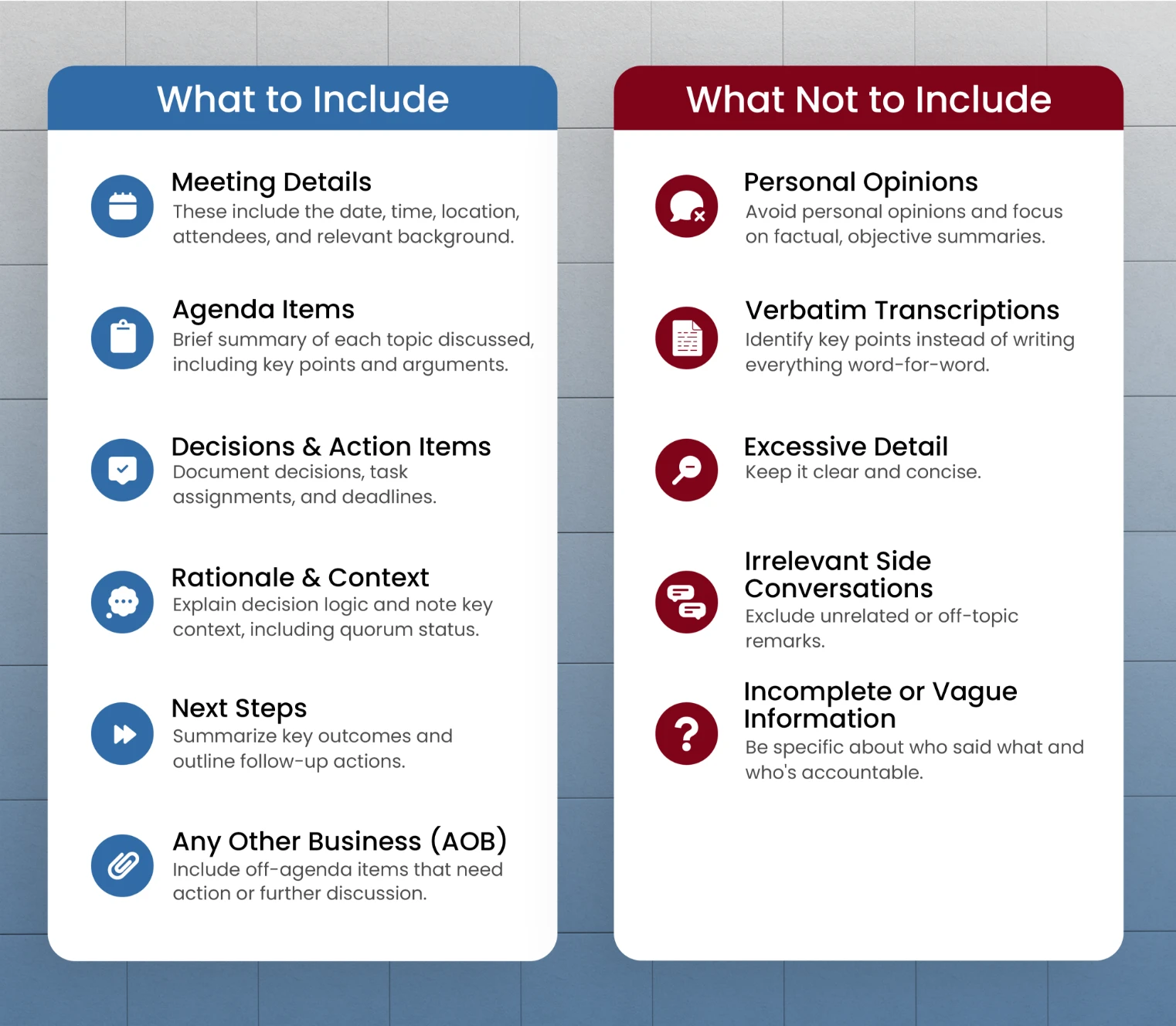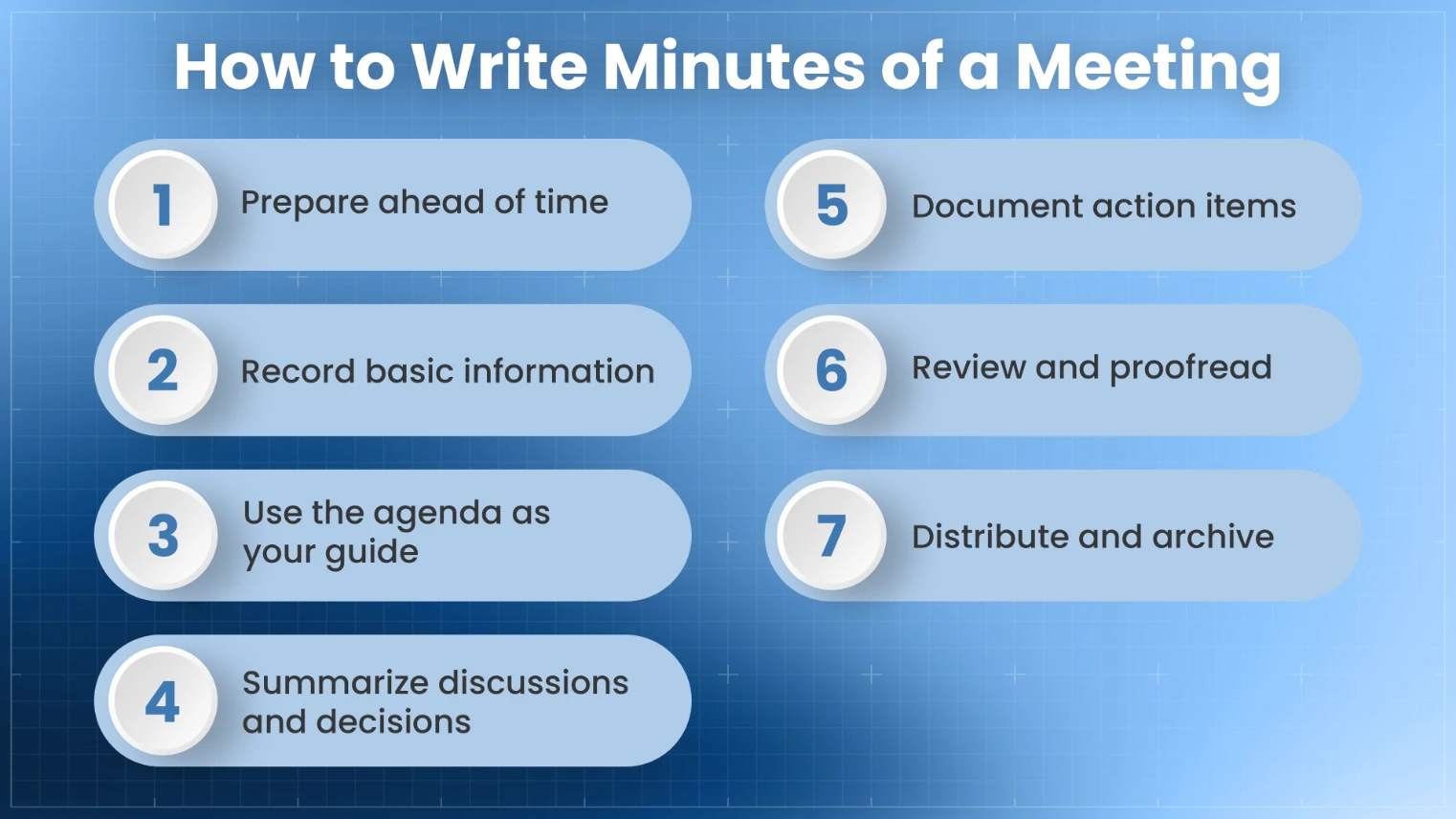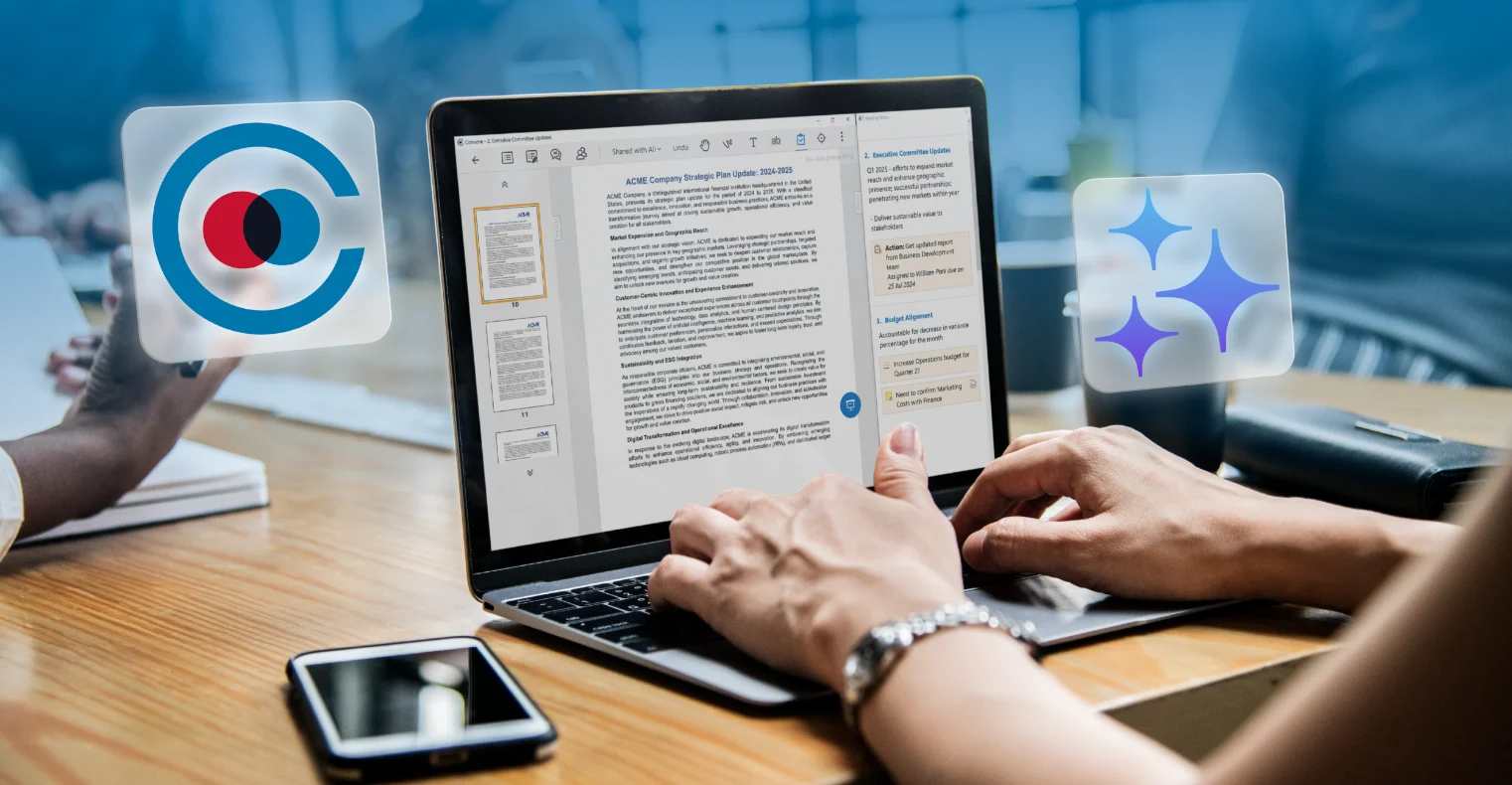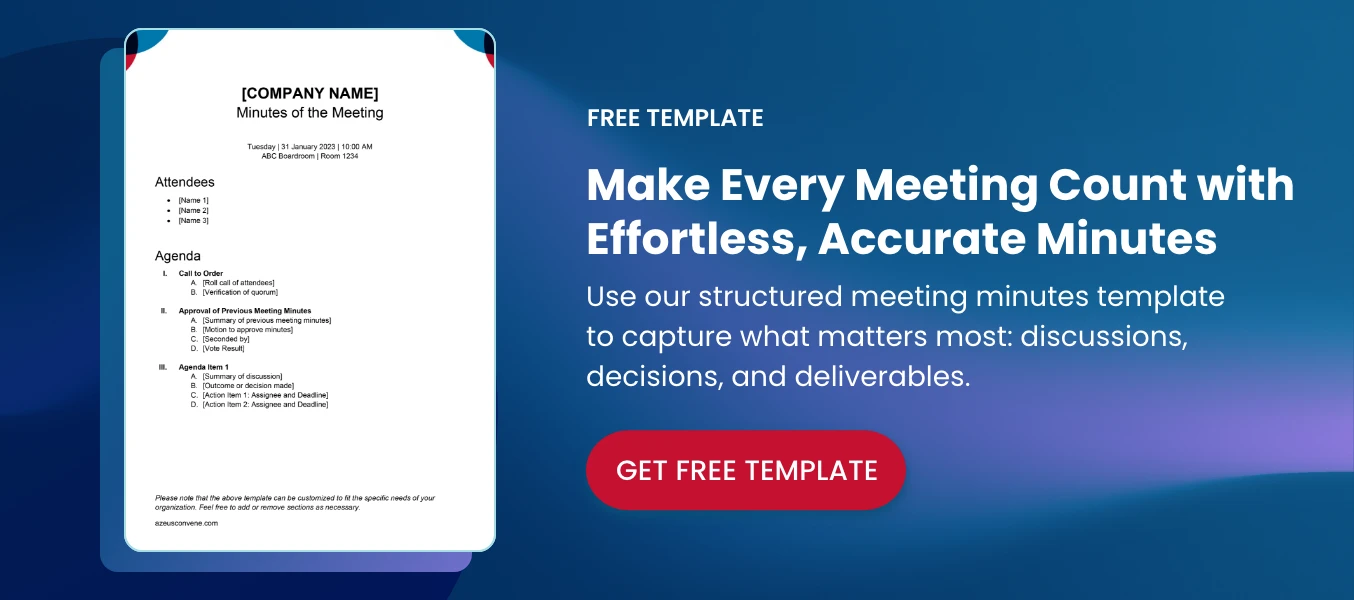Key Takeaways:
- Meeting minutes are written and official records of what was said, decided, and done during a meeting.
- The person in charge of taking minutes, typically the board secretary, is responsible for writing down complete and accurate points without adding unnecessary details.
- The length of the meeting minutes may vary, but the best practice is to keep them concise and to the point.
- It is best to send the minutes to the attendees within one to two days after the meeting to reinforce accountability and keep everyone aligned. To simplify this task, most companies use meeting tools like the Convene board portal.
Taking minutes at a meeting is a crucial task for effective communication and decision-making within organizations. However, it is not just about writing down everything word for word. Effective minutes focus on the critical points of the meeting and should have a clear structure and clarity. This is especially important in a board setting, where minutes serve as the official record of the governance decisions made by the board.
In this guide, we will explore what minutes of a meeting are, their importance, and how to take board meeting minutes effectively. Plus, download a free board meeting minutes template to streamline the process! For a more seamless experience, explore an all-in-one board solution that combines minute-taking features and document management capabilities. Read until the end of the article to know more.
What are board meeting minutes?
Board meeting minutes are written records that capture important discussions, decisions, and action items from a meeting. The keyword here is important because minute takers are not transcribing the entire conversation but highlighting the takeaways that matter.
These minutes serve as a reference for both attendees and absentees, summarizing the topics discussed, agreements reached, and tasks assigned. They usually include essential details, such as the meeting’s date, time, and location, a list of who attended, and a brief rundown of each agenda item.
Who writes the minutes?
The minute taker, typically the board secretary, is responsible for accurately recording the discussions and outcomes of a meeting. Their role is to actively listen, observe, and clearly and concisely convey the main points. Since they are acting in an administrative capacity, the minute taker should remain unbiased and objective, focusing on factual information rather than personal opinions. Attention to detail, strong organizational skills, and the ability to synthesize information are essential for an effective minute taker.
Why are board meeting minutes important?
The purpose of the board meeting minutes is to help promote transparency and accountability within an organization. They serve as an official record of the meeting’s proceedings, documenting decisions, action items, and responsibilities. Moreover, minutes help with information recall. With a written log, participants can stay informed, be reminded of their commitments, and provide a historical reference for future meetings. They also serve as evidence of compliance with regulations and organizational requirements.
Corporate vs. Nonprofit Board Meeting Minutes
While both nonprofits and corporations are required to keep minutes of a meeting, their focus and legal implications can differ. Corporate minutes tend to highlight fiduciary decisions and board resolutions that impact shareholders. On the other hand, nonprofit board meeting minutes often emphasize mission alignment, program updates, and compliance with donor or grant requirements. Regardless of the type, both must maintain accurate, well-structured records for accountability and legal protection.
Best Practices in Taking Board Meeting Minutes
When it comes to taking board meeting minutes, knowing what to capture and what to leave out is just as important as the act of recording itself. This tip sheet provides guidance on what to include and what to exclude, ensuring the creation of accurate and valuable records.

What to Include (Best Practices)
- Meeting Details: These include the date, time, and location of the meeting, as well as the names and roles of attendees, and any relevant background information or context that may be necessary for better understanding.
- Agenda Items: This should be a clear and concise summary of each agenda item discussed. Also, include key points, ideas, and arguments raised during the discussion.
- Decisions and Action Items: Document decisions made during the meeting. Outline action items, including tasks, responsible individuals, and deadlines. Don’t forget to also specify any dependencies or follow-up required.
- Rationale and Context: Provide a brief explanation of the reasoning behind decisions. Be sure to include important contextual information that influenced discussions, including whether a quorum is met for attendance and decision items.
- Next Steps: Summarize the key outcomes of the meeting, and outline any follow-up actions or tasks assigned.
- Any Other Business (AOB): Note down any additional topics raised that were not part of the main agenda but are still worth recording, especially if they may require action or further discussion in future meetings.
What Not to Include (Common Mistakes to Avoid)
- Personal Opinions: As previously mentioned, avoid including personal opinions or biases in the board meeting minutes. Focus on factual information and objective summaries of discussions.
- Verbatim Transcriptions: It is not necessary to record every word spoken during the meeting. Instead, identify the essence of the discussions and important points.
- Excessive Detail: Keep the minutes concise and to the point. Avoid including unnecessary details that do not contribute to the record.
- Irrelevant Side Conversations: Exclude unrelated conversations or discussions that are not directly related to the agenda items.
- Incomplete or Inaccurate Information: Ensure that the board meeting minutes accurately reflect the discussions and decisions made. Avoid vague phrases like “it was agreed” or “a suggestion was made”; instead, clearly state who made specific comments and who agreed or took responsibility. For accuracy, double-check points of contact, assigned action items, and other critical details.
How to Write Minutes of a Meeting: 7 Easy Steps
Taking minutes requires the right techniques and a systematic approach. In this section, we’ve outlined a series of steps to guide you through how to write minutes of a meeting:

Step 1: Prepare ahead of time
Before the meeting begins, take time to review all relevant materials. This includes the meeting agenda, past minutes of a meeting, reports, and any supporting documents. Knowing what topics will be discussed helps you anticipate what information to focus on. It’s also helpful to confirm who will be attending and whether any key decisions are expected.
Step 2: Record basic information
At the beginning of your board meeting minutes document, include the essentials: the meeting’s date, time, and location; a list of attendees and their roles; and the names of any absentees. You should also note the name of the person taking the minutes. These details may seem routine, but they are important for context, future reference, and for verifying quorum if needed.
Step 3: Use the agenda as your guide
Going back to the first tip, review the agenda and then use it as your framework for the board meeting minutes. Copy it into your notes ahead of time and create headings or sections for each agenda item. This helps keep your minutes organized and aligned with the meeting’s flow, making it easier to track discussions and decisions for each topic as they happen.
Step 4: Summarize discussions and decisions
During the meeting, actively listen and take notes on the key points discussed. Keep it concise and refrain from including personal opinions or irrelevant details. Note any major arguments or considerations that influenced decisions. Record final decisions clearly, including who made a motion, who seconded it, and the outcome of any votes. If clarification is needed, don’t hesitate to ask for it during the meeting. Relying on memory alone may lead to misinformation.
Step 5: Document action items
One of the most critical parts of board meeting minutes is the list of action items. For each task assigned, include the assignee’s name, the task description, and the deadline or due date. This ensures accountability and allows for easy tracking of progress. If applicable, you can also include any dependencies or conditions tied to the task.
Step 6: Review and proofread
After the meeting, take time to review your notes while the discussion is still fresh in your mind. Leaving it unattended for too long may result in errors and gaps in detail. Check for any typos or mistakes (especially of names and technical terms) and make necessary corrections. The goal is to create clear, complete, and professional board meeting minutes that can stand as an official record.
Step 7: Distribute and archive
Once finalized, distribute the minutes to the attendees within one to two days. Timely distribution helps reinforce accountability and keeps everyone aligned. Be sure to store the final version in a central, secure location, such as a shared drive, board portal, or document management system, so it’s easily accessible for future reference.
Remember, board meeting minutes should be objective, factual, and concise. They serve as a formal record of the meeting and should capture the most critical information without unnecessary details.
Access Your Free Board Meeting Minutes Template
Streamline your board meeting documentation with our customizable board meeting minutes template. Click below to download and simplify your minute-taking process today!
Most Commonly Used Software for Taking Board Meeting Minutes
Whether you’re drafting minutes live during the meeting or compiling them afterward, the right software can save you time and keep everything organized in one place.
Here are some of the most effective tools for taking board meeting minutes:
- Otter.ai: This audio-to-text translator automatically transcribes meetings in real-time with speaker identification. You can highlight key decisions and action items during the meeting, and then edit the transcript afterward to create formal minutes.
- Microsoft OneNote: Ideal for those who prefer the feel of writing but want the convenience of digital tools. OneNote allows for structured note-taking with customizable sections for agenda items, decisions, and action items. It syncs across devices, making it easy to format, organize, and share minutes with board members.
- Notion: Combines note-taking with task management. It is an all-in-one workspace application that enables users to create templates for consistent minute-taking formatting, assign action items to specific individuals, and track follow-up tasks between meetings.
- Google Docs: Simple collaborative editing allows multiple people to contribute during the meeting. Easy sharing and commenting features make it straightforward to distribute draft minutes for review and approval.
- Convene Board Portal: Purpose-built board management platforms like Convene offer all-in-one solutions with built-in automation tools and advanced security features. From automated agenda management and minute-taking to secure document sharing and role-based access controls, these tools streamline meeting processes while protecting sensitive board information.
Frequently Asked Questions About Board Meeting Minutes
In this section, we address common questions related to taking minutes at a meeting. Whether you’re a seasoned minute taker or new to the role, this FAQ section will help you navigate the challenges of capturing effective meeting minutes.
1. How long should the minutes of a meeting be?
Board meeting minutes should be concise and focused. While the length may vary depending on the meeting’s complexity, only take note of the key points without including unnecessary details. Aim for a comprehensive summary that remains easily digestible.
2. How can I ensure the confidentiality of the board meeting minutes?
To ensure confidentiality and security, use secure file-sharing platforms or encrypted email to distribute board meeting minutes. Be mindful of sharing minutes only with authorized individuals, and consider implementing access controls. Safeguarding sensitive information is crucial for maintaining privacy and protecting organizational data.
3. How long should I retain board meeting minutes?
Retention periods vary based on legal and organizational requirements. Generally, it is recommended to keep meeting minutes for one to three years. Consult your organization’s policies or legal guidelines for the appropriate duration.
4. How can I improve my minute-taking skills?
Enhance minute-taking skills by actively listening, practicing effective note-taking techniques, and developing real-time information synthesis. Regularly review and analyze your minutes for accuracy and clarity. Seek feedback and training opportunities for continuous improvement.
Take Better Board Meeting Minutes with Convene

Effective board meeting minutes could be a strategic tool for improving decisions in organizations. Convene, a modern board meeting app, offers valuable assistance in taking minutes, easily and more accurately.
Convene’s Meeting Minutes Workflow makes the entire process seamless, from minute-taking and approval to distribution. Minute-takers can effortlessly record discussions and decisions during live meetings using the Minute Taker Tool. To make the task less daunting, users can quickly generate draft minutes using the customizable template.
Now, with the introduction of Convene AI, the process becomes even smarter. This latest integration brings AI-powered support into your boardroom, helping leaders and administrators save time and improve the quality of their minutes. Key features include AI-generated meeting summaries, action items, and the meeting minutes themselves.
Discover how Convene can help you take effective board meeting minutes. Book a demo now!
Jielynne is a Content Marketing Writer at Convene. With over six years of professional writing experience, she has worked with several SEO and digital marketing agencies, both local and international. She strives in crafting clear marketing copies and creative content for various platforms of Convene, such as the website and social media. Jielynne displays a decided lack of knowledge about football and calculus, but proudly aces in literary arts and corporate governance.











